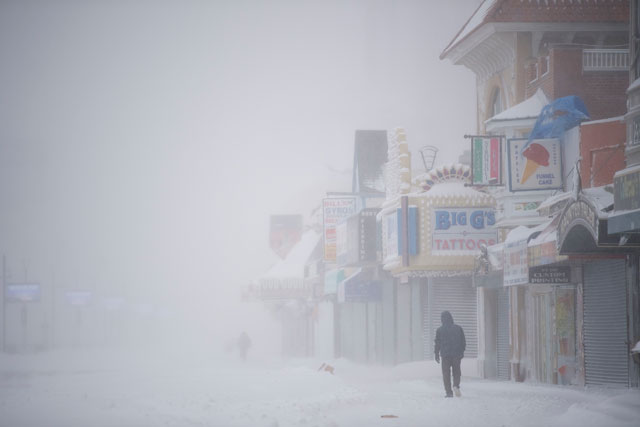
 A man walks on the snow-covered boardwalk during a snowstorm on January 4, 2018, in Atlantic City, New Jersey. A “bomb cyclone” winter storm has caused every East Coast state from Maine to Florida to declare at least one weather advisory, winter storm watch, winter storm warning or blizzard warning. (Photo: Mark Makela / Getty Images)
A man walks on the snow-covered boardwalk during a snowstorm on January 4, 2018, in Atlantic City, New Jersey. A “bomb cyclone” winter storm has caused every East Coast state from Maine to Florida to declare at least one weather advisory, winter storm watch, winter storm warning or blizzard warning. (Photo: Mark Makela / Getty Images)
On January 2, it was colder in Jacksonville, Florida (38 degrees) than it was in Anchorage, Alaska (44 degrees, which tied a record high for that city).
What is wrong with this picture, in addition to the obvious?
Since December 27, at least a dozen people have died from Arctic-cold temperatures that have covered much of the United States, as wind-chill and freezing advisories were issued by the National Weather Service from the border of Canada down to southern Texas, and from Montana all the way across to Maine.
What’s causing the chaotic temperatures? To understand them, we need to look at the globe’s northernmost regions. The Arctic’s extremely cold air is usually trapped within a circular weather pattern known as the Polar Vortex. Prior to anthropogenic climate disruption (ACD), that weather pattern was intact and strong, which kept the Arctic’s freezing cold air trapped in the Arctic.
But now, thanks to ACD along with natural variability, that weather pattern is changing, and possibly for good.
What It Means
As global weather patterns are becoming increasingly disrupted by ACD, the polar vortex is being weakened, which is allowing the freezing air to flow out of that region and head south across Canada — and as far down as southern Texas this week.
The total area of global tree cover lost last year was equivalent to the area of the country of New Zealand (approximately 73.4 million acres). This was a staggering 51 percent increase over the previous year’s loss. The University of Maryland study that provided this data cited ACD-driven forest fires and deforestation as the two leading causes, and noted that the wildfires were responsible for the massive spike in coverage loss compared to the previous year.
That phenomenon used to be extremely rare, but is becoming increasingly common as ACD impacts intensify. What is also rare is how long this intense cold snap across the US is lasting — 10 days now and counting.
On Tuesday, for example, Boston tied its seven-day record for the most consecutive days at or below 20 degrees. Meanwhile, during the last week of December more than 1,600 cold temperature records were either tied or broken across the US, making it the second coldest week on record for the country.
As cold as it has been throughout many of the 48 contiguous states, Alaska and other parts of the Arctic are seeing record-warm temperatures.
In addition to the January 2 record in Anchorage, temperatures across the Arctic on that same day were more than 6 degrees warmer than normal.
A study published by the American Meteorological Society in September 2017 found that, since 1990, the polar vortex has weakened and meandered more than it had before. The study also reported that the weakening of the vortex was most likely being set in motion by a rapidly warming and melting Arctic region, which was resulting in colder winters across Europe — and occasionally the US.
Danger Compounded by Trump’s Denialism
On December 28, President Donald Trump tweeted:
In the East, it could be the COLDEST New Year’s Eve on record. Perhaps we could use a little bit of that good old Global Warming that our Country, but not other countries, was going to pay TRILLIONS OF DOLLARS to protect against. Bundle up!
— Donald J. Trump (@realDonaldTrump) December 29, 2017
Jason Furtado, a University of Oklahoma meteorology professor, told the Associated Press that it is important not to confuse weather with climate. Weather is something that occurs over a period of a few weeks or less in one region, whereas climate occurs over a period of years or decades and is global.
“A few cold days doesn’t disprove climate change,” Furtado said. “That’s just silly. Just like a couple down days on the stock market doesn’t mean the economy is going into the trash.”
Over the last year, there have been approximately three record high temperatures set across the US for every record low temperature.
Furthermore, the last for years have been the four hottest years ever recorded for the planet.
More than 97 percent of climate scientists agree that ACD is real, and that the prime driver of it is CO2 and other greenhouse gas emissions stemming from human activity. Of the less than 3 percent of climate scientists who doubt or dispute that fact, the vast majority have been shown to be funded by the fossil fuel industry.
Join us in defending the truth before it’s too late
The future of independent journalism is uncertain, and the consequences of losing it are too grave to ignore. To ensure Truthout remains safe, strong, and free, we need to raise $50,000 in the next 9 days. Every dollar raised goes directly toward the costs of producing news you can trust.
Please give what you can — because by supporting us with a tax-deductible donation, you’re not just preserving a source of news, you’re helping to safeguard what’s left of our democracy.